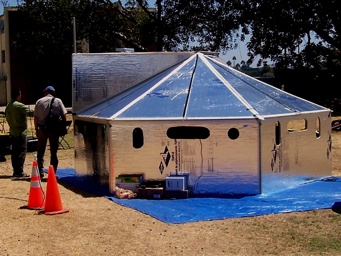New Hexayurt Project Blurb
by Vinay Gupta • October 7, 2008 • Hexayurt • 0 Comments
Please post any feedback you have on the new blurb in the comments. Much appreciated, thank you.
Download the PDF here.
The Hexayurt Project in a nutshell.
The Hexayurt is an extremely simple disaster relief shelter which is designed to replace tents in many applications. Its unique feature is that it can be mass produced from a wide range of materials in simple or even improvised factories, or field-fabricated in about an hour with semi-skilled labor.
The key feature of the design is that it uses whole 4’ x 8’ / 1.2 x 2.4 meter panels. Six panels are cut into triangles to form the roof, six more form the walls. The building is often made with strong tape and guyed like a tent.
A folding hexayurt also exists, where the entire building concertinas flat and can be unfolded again, ready for use, in 5 minutes. High density shipping of units is possible either by using thin, strong walls, or by shipping compressed materials (honeycombs) which are made into panels and then completed hexayurts on site.
The Hexayurt is a step to regional shelter self-sufficiency. Take Bangladesh. In many years, Bangladesh experiences severe flooding displacing millions. However, there are panel factories in Northern Indian industrial cities which could effectively and easily turn out Hexayurts from their panel output during times of crisis, then return to their regular products afterwards. This also means that shelters can be trucked to disasters rather than being air freighted. This represents a considerable saving of time and money. The design is free of all patent and copyright, permitting it to be replicated freely anywhere.
Many reasonably-priced materials are good for 3, 5 or even 20 years in the outdoors. In a refugee camp or transitional housing setting, a building costing only two to three times the cost of a one-season disaster relief then could be provided to long stay displaced families. The folding design allows families to take the shelter back with them when they can finally return to their lands, and keep using the shelter while they regain economic self sufficiency and repair their home.
Along side the shelter, there is a Hexayurt Infrastructure Package which is an approach to providing drinking water, cooking, sanitation and all other essential services using appropriate technology designs drawn from the public domain and suitable for low cost mass production. This approach, of providing infrastructure at the household level, means that large encampments can be resettled to individual villages when the time comes. Tools that were originally given as disaster relief can become development aid if they are durable and can be taken home by the refugees or disaster victims when normality is restored. Dissolving the line between disaster relief and development aid is the key to clarifying the goal of disaster relief in the developing world: to restore economic self-sufficiency to people who may have lost it all.


